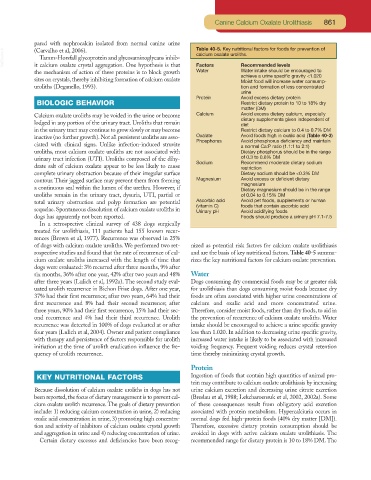Page 830 - Small Animal Clinical Nutrition 5th Edition
P. 830
Canine Calcium Oxalate Urolithiasis 861
pared with nephrocalcin isolated from normal canine urine Table 40-5. Key nutritional factors for foods for prevention of
VetBooks.ir (Carvalho et al, 2006). calcium oxalate uroliths.
Tamm-Horsfall glycoprotein and glycosaminoglycans inhib-
it calcium oxalate crystal aggregation. One hypothesis is that
Recommended levels
Factors
the mechanism of action of these proteins is to block growth Water Water intake should be encouraged to
achieve a urine specific gravity <1.020
sites on crystals,thereby inhibiting formation of calcium oxalate Moist food will increase water consump-
uroliths (Deganello, 1993). tion and formation of less concentrated
urine
Protein Avoid excess dietary protein
BIOLOGIC BEHAVIOR Restrict dietary protein to 10 to 18% dry
matter (DM)
Calcium oxalate uroliths may be voided in the urine or become Calcium Avoid excess dietary calcium, especially
dietary supplements given independent of
lodged in any portion of the urinary tract. Uroliths that remain diet
in the urinary tract may continue to grow slowly or may become Restrict dietary calcium to 0.4 to 0.7% DM
inactive (no further growth).Not all persistent uroliths are asso- Oxalate Avoid foods high in oxalic acid (Table 40-3)
Phosphorus Avoid phosphorus deficiency and maintain
ciated with clinical signs. Unlike infection-induced struvite a normal Ca:P ratio (1.1:1 to 2:1)
uroliths, most calcium oxalate uroliths are not associated with Dietary phosphorus should be in the range
urinary tract infection (UTI). Uroliths composed of the dihy- of 0.3 to 0.6% DM
Sodium Recommend moderate dietary sodium
drate salt of calcium oxalate appear to be less likely to cause restriction
complete urinary obstruction because of their irregular surface Dietary sodium should be <0.3% DM
contour. Their jagged surface may prevent them from forming Magnesium Avoid excess or deficient dietary
magnesium
a continuous seal within the lumen of the urethra. However, if Dietary magnesium should be in the range
uroliths remain in the urinary tract, dysuria, UTI, partial or of 0.04 to 0.15% DM
total urinary obstruction and polyp formation are potential Ascorbic acid Avoid pet foods, supplements or human
(vitamin C) foods that contain ascorbic acid
sequelae. Spontaneous dissolution of calcium oxalate uroliths in Urinary pH Avoid acidifying foods
dogs has apparently not been reported. Foods should produce a urinary pH 7.1-7.5
In a retrospective clinical survey of 438 dogs surgically
treated for urolithiasis, 111 patients had 155 known recur-
rences (Brown et al, 1977). Recurrence was observed in 25%
of dogs with calcium oxalate uroliths. We performed two ret- nized as potential risk factors for calcium oxalate urolithiasis
rospective studies and found that the rate of recurrence of cal- and are the basis of key nutritional factors. Table 40-5 summa-
cium oxalate uroliths increased with the length of time that rizes the key nutritional factors for calcium oxalate prevention.
dogs were evaluated: 3% recurred after three months, 9% after
six months, 36% after one year, 42% after two years and 48% Water
after three years (Lulich et al, 1992a). The second study eval- Dogs consuming dry commercial foods may be at greater risk
uated urolith recurrence in Bichon Frise dogs. After one year, for urolithiasis than dogs consuming moist foods because dry
37% had their first recurrence; after two years, 64% had their foods are often associated with higher urine concentrations of
first recurrence and 8% had their second recurrence; after calcium and oxalic acid and more concentrated urine.
three years, 90% had their first recurrence, 15% had their sec- Therefore, consider moist foods, rather than dry foods, to aid in
ond recurrence and 4% had their third recurrence. Urolith the prevention of recurrence of calcium oxalate uroliths. Water
recurrence was detected in 100% of dogs evaluated at or after intake should be encouraged to achieve a urine specific gravity
four years (Lulich et al, 2004). Owner and patient compliance less than 1.020. In addition to decreasing urine specific gravity,
with therapy and persistence of factors responsible for urolith increased water intake is likely to be associated with increased
initiation at the time of urolith eradication influence the fre- voiding frequency. Frequent voiding reduces crystal retention
quency of urolith recurrence. time thereby minimizing crystal growth.
Protein
KEY NUTRITIONAL FACTORS Ingestion of foods that contain high quantities of animal pro-
tein may contribute to calcium oxalate urolithiasis by increasing
Because dissolution of calcium oxalate uroliths in dogs has not urine calcium excretion and decreasing urine citrate excretion
been reported,the focus of dietary management is to prevent cal- (Breslau et al, 1988; Lekcharoensuk et al, 2002, 2002a). Some
cium oxalate urolith recurrence. The goals of dietary prevention of these consequences result from obligatory acid excretion
include: 1) reducing calcium concentration in urine, 2) reducing associated with protein metabolism. Hypercalciuria occurs in
oxalic acid concentration in urine, 3) promoting high concentra- normal dogs fed high-protein foods (40% dry matter [DM]).
tion and activity of inhibitors of calcium oxalate crystal growth Therefore, excessive dietary protein consumption should be
and aggregation in urine and 4) reducing concentration of urine. avoided in dogs with active calcium oxalate urolithiasis. The
Certain dietary excesses and deficiencies have been recog- recommended range for dietary protein is 10 to 18% DM.The

